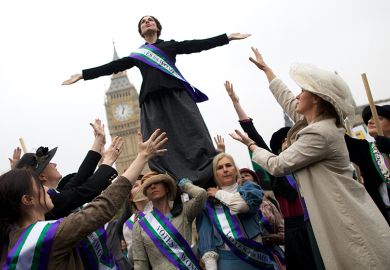If thou must love me'', Elizabeth Barrett Browning wrote, in one of her "Sonnets from the Portuguese", "let it be for nought/Except for love's sake only. Do not say/'I love her for her smile . . . her look . . . her way/Of speaking gently'". For too long, women's poetry has been ''loved'' for the wrong reasons, for the fact that it was written by women, for its depiction of the harshness of the female lot, for its exotic marginality or what Germaine Greer has called the "flying-pig syndrome''.
In many ways, the fashion of studying women's poetry simply because it was composed by women was a necessary development in literary criticism. Until recently, the poetry canon has been almost exclusively male. Barrett Browning famously declared, when wanting to place her work in some kind of tradition, "I look everywhere for grandmothers and see none''. To counter the narrowness of the established male canon, feminist critics and publishers - notably Virago - have gone in for some literary archaeology, unearthing previously buried and forgotten works by women and displaying them for their curiosity value. The acme of this project was Roger Lonsdale's edition of Eighteenth-Century Women Poets (1989), which succeeded in discovering a great range of unknown writers. For Lonsdale and his readers, the chief interest of the book lay in appreciating that these poets had existed at all and his introduction revelled in the diversity and obscurity of the book's contents.
But criticism has moved on. Nearly every university has courses on women's writing and poets like Anne Finch and Anna Laetitia Barbauld are becoming familiar. Some have reacted to the frenzied quest for female poets with a sceptical backlash. Greer surprised many when she argued in Slip-shod Sibyls (1995) that "the problem that confronts the student of women's creativity is not that there is no poetry by women but that there is so much bad poetry by women'' and that aesthetic standards of evaluation, regularly applied to male poetry are not adopted when critics approach writing by women.
Others have begun actually developing the different standards of evaluating female poetry. Isobel Armstrong and Joseph Bristow's Nineteenth-Century Women Poets offers a fine, and almost certainly influential, example of this new approach. Armstrong and Bristow are concerned, beyond the expected task of researching and collecting poems required by any anthology editor, to trace common themes and subjects and to discern the poetics which are peculiar to women's poetry. In other words, it is no longer enough, according to Armstrong and Bristow, that women were authors; the interest now is in what they wrote about and, in particular, how they wrote.
In the absence of a conventional narrative of female aesthetics in the 19th century, Armstrong and Bristow have had to invent literary terms for female poetic craftsmanship, arguing in the introduction that women drew upon two principal genres, the "monumental legend'' and the "oceanic monody''. These genres, they maintain, developed later into dramatic poetry and the lyric, as the optimistic belief in the communality of experience at the beginning of the century disintegrated into a recognition of fragmentation, incommunicable differences and isolation. Dramatic poetry, with the necessarily ambiguous voice of the narrator obfuscating transparent communication, lent itself to the sceptical and fragmented world which women inhabited by the second half of the century: I tell my secret? No indeed, not I: Perhaps some day, who knows?
But not today; it froze, and blows, snows, And you're too curious; fie!
(Christina Rossetti) With its emphasis on genre and poetics, this anthology marks an ambitious new development. Only last year, Angela Leighton and Margaret Reynolds harped on the conventional theme in their anthology for Blackwells, Victorian Women Poets, by treating women's poems simply as confessional and choosing poems which recounted women's issues, like childbirth and childcare, love, death, resignation and self-sacrifice. In contrast, Armstrong and Bristow have chosen poems, usually by the same poets, which are self-consciously crafted, which tease the reader, which are obviously sophisticated and literary. Caroline Clive's "Written in Illness'' (1840), for instance, tantalisingly juxtaposes physical and psychological reality, using the "oceanic'' genre to gain this fluidity: "My bark floats on the sea of death,/Of deepening waves the sport;/And dull disease, with heavy breath,/Impels me from the port." Similarly, Maria Jane Jewsbury's series of poems, the Oceanides (1833), adopts the bottomless ocean as a model for evading male poetic tradition: "Seas that never lead may sound/ Seas that have for man no ground''.
Not only do Armstrong and Bristow's poets seem more self-consciously sophisticated than Leighton and Reynolds's; they seem more professional too. The Blackwells introduction to each poet stressed female struggles and described marriage as a destructive but inevitable fate to be endured. Armstrong and Bristow describe the marriages of their writers in more neutral terms as one of a number of often fruitful alliances made with a wider social network. Their writers are allowed to mix as freely with men as with women, and also to write about conventional male subjects. Menella Bute Smedley, for example, is represented only by two poems, "Garibaldi at Varignano'' (1863) and "Lines on the Greek Massacre'' (1870). The strong political emphasis in Armstrong and Bristow's anthology derives partly from the fact that it includes the whole of the 19th century, rather than strictly the Victorian period, and so can incorporate the poems of, for example, Anna Laetitia Barbauld and Helen Maria Williams, who became caught up in the fervour and ideas of the French revolution. The political emphasis is also derived from the focus upon the regions and colonies of Britain since some of the most striking poetry emerges from the double otherness of gender and place. The Irish writer Louisa Stuart Costello upsets the established patriotic genre in "On Reading the Account of the Battle of Waterloo": "Oh! who can listen with delight/To tales of battles won?"; while Jewish writer Grace Aguilar provides an interesting twist to the hymn-writing genre traditional to women.
If there is a criticism, it is that Armstrong and Bristow have excised a large number of poems which, like-it-or-hate-it, constituted a significant part of female writing. There are hardly any lullabies, none of Christina Rossetti's poems for children, and very few of the Sappho-Corinne, woman-as-suffering-artist poems which have dominated previous collections. Literary phenomena such as the notorious and influential L. E. L. are more difficult to understand if the poems which celebrated the life rather than the art of a writer are ignored.
This is an exciting moment in women's studies. While a canon of female writers has emerged in the last decade, the notion of which of their poems should be considered canonical has not. Very few of the poems chosen by Armstrong and Bristow overlap with the Blackwells selection last year. With the female tradition still up for grabs, and indeed much of Victorian poetry in general only just emerging from the blanket condemnation of sentimentality, this book offers some important critical criteria by which to judge the poetry of the last century. Were she to glance through, EBB might discover not only grandmothers, but sisters, cousins and nieces, who turn out to be a lot more interesting than previously thought, and not at all slip-shod.
Jennifer Wallace is director of studies in English, Peterhouse, Cambridge.
Nineteenth-Century Women Poets
Editor - Isobel Armstrong and Joseph Bristow
ISBN - 0 19 811290 4
Publisher - Oxford University Press
Price - £25.00
Pages - 826
Register to continue
Why register?
- Registration is free and only takes a moment
- Once registered, you can read 3 articles a month
- Sign up for our newsletter
Subscribe
Or subscribe for unlimited access to:
- Unlimited access to news, views, insights & reviews
- Digital editions
- Digital access to THE’s university and college rankings analysis
Already registered or a current subscriber?



